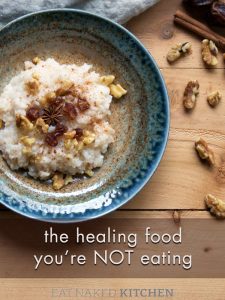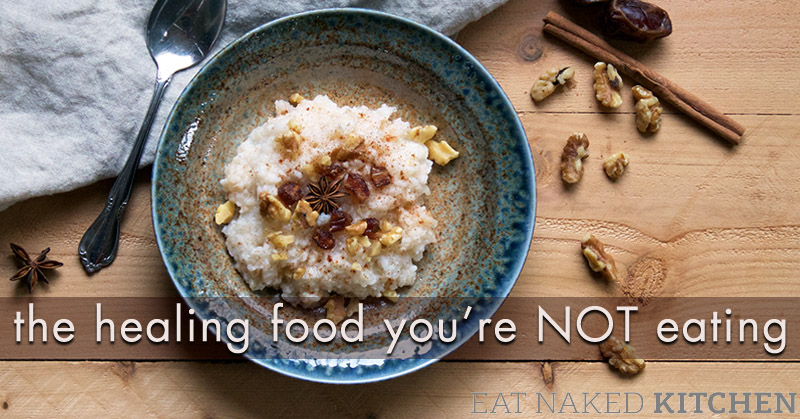This article is a guest post by my dear friend and esteemed colleague, Elaina Greenberg, LAc. Elaina is one of the most gifted acupuncturists I know and generously offered to share her wisdom on a healing food many of you have probably never heard of, let alone eaten: congee. This is a traditional healing food in Asian cultures and she’ll explain why it’s so good for you and how to make it. Enjoy!
A traditional breakfast in China and one of the purest examples of food as medicine is congee. This is an ideal slow cooker meal, where you prepare it at night and by morning have a breakfast that is the most healing meal of the day. A principle in congee making is the longer it cooks, the stronger the medicine, so an overnight porridge is ideal.
Congee itself is said to strengthen Qi (pronounced “chee”) and nourish the Blood. It harmonizes digestion and is demulcent or soothing in nature. For new mammas, it also can increase milk supply because of the way it nourishes the blood. The rice is sweet and bland in flavor, which supports the middle burner, basically the Chinese digestive system.
There are some fundamental ways that Chinese medicine is different from the western perspective of the body. For one, the classical Chinese view of health cannot be separated from our external environment. Living and eating with the seasons is paramount to promoting longevity and dispelling malaise.

This time of year where the energy is moving downward and inward is our time to cultivate that stillness and really nourish our reserves. The Chinese talk about pre-heaven Qi and post-heaven Qi. The energy that we are born with, our essence, is our pre-heaven Qi. The energy that we cultivate from food and healthy lifestyle is our post-heaven Qi. By optimizing the post-heaven Qi, essentially our renewable resource, we promote longevity and health because we do not need to tap into our reserves (pre-heaven Qi).
Now, rice porridge may seem a bit boring, kind of bland. I get it. Here is where it gets fun. You can add other vegetables, herbs, grains, or even meats to not only bring flavor but to enhance the congee’s therapeutic properties. In Chinese medicine, food and herbs have an energetic, meaning that they have a temperature (other then what you cook it on) as being warming, cooling, hot, cold, or neutral in nature. They have a directionality or movement into specific organs or regions of the body such as moving towards the interior, expressing towards the exterior, moving above the waist, or down below the waist. Each ingredient you add will have a different energetic, and thus a different influence on your body.
How to make congee
Start with one part rice to six parts water and add it to your slow cooker on low or a pot set on the lowest temperature your stove will do. You can add some of the following depending on your individual need:
- Ginger / Sheng Jiang – dispels cold, treats nausea and vomiting
- Dates / Da Zao – give an extra sweetness and added support to the digestive system
- Wolf berries / Gou Qi Zi – nourishes the blood and benefits the eyes
- Walnuts – supports the brain and Kidneys* (see below)
- Cinnamon / Gui Zhi – relieves abdominal pain from cold, treats diarrhea
- Carrot – a digestive aid, helps eliminate intestinal gas
- Chestnut – strengthens the knees and low back, supports the Kidneys* (see below)
- Honey – benefits the lungs, treats constipation and dry cough
- Pear – treats cough and supports the lungs
Cook it on low heat overnight for a minimum of 8 hours.
MF note: My personal favorite combination – and the one shown in the photo – is cinnamon, a couple of dates, and walnuts, which I add after it has cooked so that they’re still crunchy. It’s so nourishing!
So that is the food part. Here are some combinations for specific health issues:
- To promote digestion – apple, coriander, beef (think bone broth), garlic
- To ease constipation – walnuts (lubricates the intestines), pear, honey
- To alleviate fatigue – chicken, sweet potato, licorice
- To relieve discomfort from arthritis – spring onion, black bean
*An important aspect to any person new to Chinese medicine is that the Chinese organs are more of a systemic physiology versus a specific organ anatomy that has a set function. That’s a mouthful. For example, a function of the Chinese Liver is to promote the free flow of Qi and to harmonize the emotions. This is a clear distinction from the western liver that is a biochemical filtering factory located on the right side of the body tucked neatly within the ribcage. This concept is key, so if you see an acupuncturist or read an article, you want to be clear what liver the speaker is talking about. Is it the western liver or the Chinese Liver?
Remember, it is always best to consult with a licensed acupuncturist to determine whether you are dealing with a hot or cold condition, something that needs to move to the interior or to the exterior. A differential diagnosis is key in determining the most effective and safest method of care. The beautiful part of congee, using food as medicine, is that it is a component of a deeper healing that includes the season, the individual, and how we can live in an ecology that not only benefits the person but the world around us. Choosing seasonally available food and spices is key to the universal healing around us and of us.
 Elaina graduated from Bastyr University with a Master of Science in Acupuncture and Oriental Medicine in 2002. Prior to attending Bastyr, she received her Bachelor of Science in Organic Chemistry and Phytopharmacology (the chemistry of plant medicine) from The Evergreen State College. For nearly two decades, Elaina has woven traditional medicine with modern science, integrating the two disciplines to the benefit of her patients. She is in private practice in Santa Monica, CA and is a clinical supervisor at Yo San University in Los Angeles, CA. Her primary areas of interest are autoimmune disease and women’s health. Click here to learn more about Elaina and book a private session.
Elaina graduated from Bastyr University with a Master of Science in Acupuncture and Oriental Medicine in 2002. Prior to attending Bastyr, she received her Bachelor of Science in Organic Chemistry and Phytopharmacology (the chemistry of plant medicine) from The Evergreen State College. For nearly two decades, Elaina has woven traditional medicine with modern science, integrating the two disciplines to the benefit of her patients. She is in private practice in Santa Monica, CA and is a clinical supervisor at Yo San University in Los Angeles, CA. Her primary areas of interest are autoimmune disease and women’s health. Click here to learn more about Elaina and book a private session.




Interesting blog article!
Thanks for sharing!
I’d love to try some! Where do you recommend purchasing it from? Thanks!
It’s just rice and water… easy peasy to make at home!
is it a special rice, where do you buy it.
I just used plain old rice. White is the traditional rice used (and what I used – I think it was white basmati) but you can also use brown.
I’ve tried to eat Congee in Shanghai and it was served in my hotel with pickled nuts of some sort, pickled tofu, almost raw scrambled egg and all mannor of not sweet things that in combination with the fermented smell of the congee made my stomach turn. Few things do…I’m going to stick to mett for breakfast.